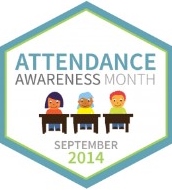September is Attendance awareness month! To celebrate, we have invited four guest bloggers to provide insight throughout the month about the importance of student attendance. In this first installment, guest blogger Hedy Chang explores how reducing chronic absence can raise student achievement.
By Hedy Chang, Director, Attendance Works
Do you know why the Local Control Funding Formula holds districts accountable for monitoring chronic absence? It is because investments in improving curriculum and instruction, including adoption of the Common Core – only make a difference if students are in the classroom. Chronic absence, missing 10{dc2081ac6c5cc81baef6ff3d8b7134abf68618b2dec130d45a21090cbaafa61c} or more of school for any reason, as early as prekindergarten and kindergarten is associated with lower third grade reading scores. By sixth grade it becomes a leading indicator that a student will drop out of high school. In ninth grade, it’s a stronger indicator of dropout than eighth grade test scores. Low-income students, who don’t have the resources to make up for time lost in classroom instruction, are especially hard hit.
This connection between attendance and achievement is hardly surprising. What is astonishing is how chronic absence is largely overlooked as a problem dragging down academic performance. Although teachers take roll every day, most districts have typically only used their attendance data to find out which kids are missing school without an excuse (truancy) or how many students show up each day (average daily attendance) so they can receive state funding. While both these measures are important, they don’t shed light on how many and which students are missing so much school they are at risk academically.
Because California is one of a handful of states that does not capture attendance in its state longitudinal student data base, only districts have the data needed to identify which students are chronically absent. Even though it is included in LCFF, most districts do not appear to be using chronic absence data to inform how they can raise achievement. An analysis of 80 district’s Local Control and Accountability Plans conducted by Fight Crime Invest in Kids, Children Now and Attendance Works revealed 18{dc2081ac6c5cc81baef6ff3d8b7134abf68618b2dec130d45a21090cbaafa61c} (less than one out of five) utilized baseline data on chronic absence! Many districts are still confused about what chronic absence is and how it differs from truancy.
The good news is chronic absence is a solvable problem. Attendance improves when schools and communities partner with families to build a culture and a habit of attendance as well as identify and address barriers to getting to class. Thanks to a new Baltimore study, we know that absences in the first month of school can predict chronic absence levels for the whole school year. This means we need to take action early before students miss so much class they fall behind. New York City successfully improved attendance by nearly two weeks for students with a past history of chronic absence by pairing them with success mentors who, starting the first day of school, offered caring relationships to motivate improved attendance and connections to needed supports. Learn more about what works from Attendance Works’ newest toolkit: The Power of Positive Connections: Reducing Chronic Absence through PEOPLE (Priority Early Outreach for Positive Linkages and Engagement)
As an educator, you are in a unique position to make a difference. You can:
- Build public awareness by celebrating Attendance Awareness Month. See http://awareness.attendanceworks.org/ for ideas about what you can do so students don’t fall off track the first month of school.
- Call for your district to calculate its chronic absence levels to identify which schools and which students need the most help.
- Use the LCAP to create accountability for reducing chronic absence and enlist a wide array of community stakeholders (businesses, public agencies, health providers, afterschool programs, etc.) to help get students to school so they can realize a brighter future.
Hedy N. Chang is the founder and director of Attendance Works, a national and state level initiative aimed at advancing student success by addressing chronic absence.







Be the first to reply